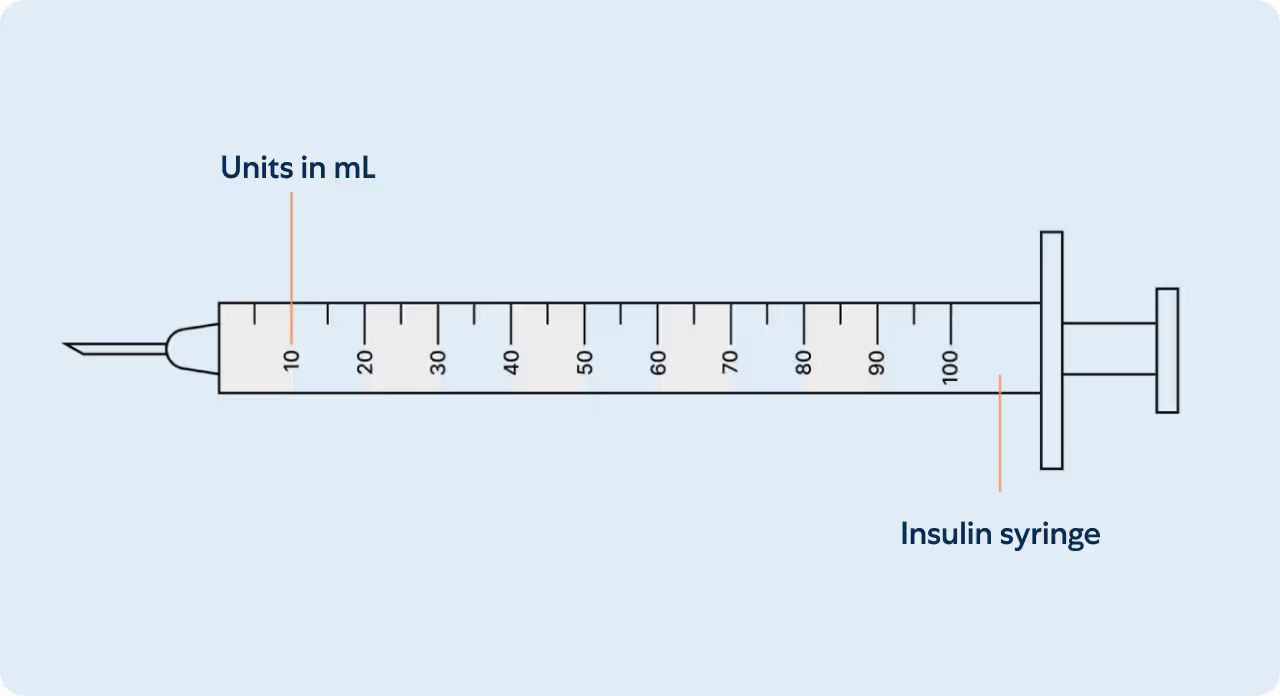Storage
Keep your vials refrigerated when not in use to maintain potency. Do not freeze, and avoid exposure to heat or direct sunlight.
Instructions
This information is intended for individuals who have been prescribed B12/MIC by their Alan Health provider.
Inject subcutaneously once every 3 days, or as directed by your healthcare provider, using a vial and syringe.
{{injection-video}}
Clean the injection site, insert the needle at a 45–90-degree angle, and inject the medication slowly. Hold until fully administered. Rotate injection sites daily to avoid irritation.
- Prep Your Supplies: Wash hands and gather the B12/MIC vial, insulin syringe, alcohol swabs, and a sharps container. Inspect the solution—it should be clear and free of particles.
- Draw the Dose: Clean the rubber top of the vial with an alcohol swab. Inject air into the vial equal to your prescribed dose, then draw up the exact amount. Remove any air bubbles by tapping the syringe and pushing gently on the plunger.
- Pick an Injection Site: Use the abdomen (at least 2 inches from the belly button), thigh, or upper arm. Clean the area with an alcohol swab and allow it to dry completely.
- Inject: Gently pinch the skin. Insert the needle at a 45–90° angle, depending on needle length and body type. Inject the medication slowly and steadily. Once done, remove the needle and apply gentle pressure with a clean swab. Dispose of the syringe safely in a sharps container.
If your medication has a seal, watch this video to learn how to remove it.
To learn how to inject your medication subcutaneously, please watch this video.
Missed Dose? If you miss a dose, skip the missed dose and continue with your regular schedule. If you have any questions about your dosing schedule, contact your Alan Health provider.
Understanding your insulin syringe

Measuring your dose
Insulin syringes are used for subcutaneous injections. They are marked in Units on the insulin syringe barrel (see illustration). Insulin syringes facilitate the precise measurement of tiny amounts of liquids which are ideal for medications such as insulin that require small and accurate dosing. Unit marks are also expressed in mL’s and can be interchangeably referenced. A prescriber may write a prescription in Units or in mL’s.
Within the amount of liquid is the prescribed mg dosage of your medication (see mg chart). Milligrams (mg) is not an amount of liquid, but rather the amount of drug that is within. The conversion between units and milligrams varies depending on the concentration of the product being used.
What can I expect?
Safety information
The most common side effects of B12/MIC injections include minor injection-site pain or redness, diarrhea, and mild itching.
In rare cases, side effects may include allergic reactions such as hives, rash, itching, swelling of the face, lips, tongue, or throat, and difficulty breathing. Very rarely, chest pain, a rapid heartbeat, or shortness of breath due to fluid retention may occur. Seek immediate medical attention if you experience any of these symptoms.
A full list of side effects can be found here.
Do not use this product if you are currently pregnant, breastfeeding, or plan to become pregnant or breastfeed without consulting a qualified healthcare provider.
Note: If you or a family member has a history of Leber’s Optic Neuropathy, do not take this medication, as B12 may cause permanent vision loss in those with this condition.
Note: The above statements have not been evaluated by the Food and Drug Administration. This product is not intended to diagnose, treat, cure, or prevent any disease.
Frequently Asked Questions
What makes B12/MIC different from regular B12?
B12/MIC offers all the benefits of standard B12 injections—like increased energy and better cell function—but adds lipotropic nutrients (Methionine, Inositol, and Choline) to further support fat metabolism, liver health, and weight loss. It’s a more targeted option for those looking to break through weight plateaus and boost metabolic results.
How does B12/MIC complement weight management programs?
B12/MIC supports weight loss by boosting energy, enhancing fat metabolism, and helping the body convert fat into usable fuel. It can make it easier to stay active, avoid fatigue, and break through plateaus—especially when combined with GLP-1s or other weight management treatments.
How does B12 / MIC support fat metabolism?
B12 helps convert fat into usable energy, while Methionine, Inositol, and Choline (MIC) assist the liver in breaking down and eliminating fat. Together, they support a more efficient metabolism.
What are the side effects of B12/MIC?
Side effects are rare but may include mild discomfort at the injection site, nausea, or digestive upset. In very rare cases, allergic reactions like itching or swelling may occur. Always consult with your provider before starting treatment.
When will I start to feel the effects?
Some people notice a boost in energy or mood within a few days, while others may see more gradual improvements in metabolism and body composition over several weeks. Consistency is key.
Can I take B12/MIC with other medications or supplements?
Yes—B12/MIC is often combined with other treatments, including GLP-1s, NAD+, and wellness supplements. However, you should always consult your provider before starting or adding any new treatments.
Is B12/MIC safe for long-term use?
Yes. When used under medical supervision, B12/MIC is considered safe for ongoing use. Your provider may adjust your frequency over time based on your progress and goals.
Do I need to refrigerate my B12/MIC product when I receive it?
Our pharmacy partners recommend refrigerating the product as soon as you receive it to maintain its potency over time. While the formulation is stable and effective without refrigeration for the first 30 days, refrigeration helps maintain potency throughout your full course of treatment.
Why isn’t it shipped with cold packaging if it needs refrigeration?
The B12/MIC compound is specially formulated to remain effective at room temperature for 30 days, which covers shipping and initial use. Because of this, cold packaging isn’t necessary, allowing for more reliable and convenient delivery.
What happens if I don’t refrigerate it right away?
No problem—if your product is kept at room temperature for a few days after delivery, it’s still safe and effective. We just recommend refrigerating it as soon as possible to preserve potency for longer-term use.
Additional support
For details about your medication and dosing, please log in to your patient portal. Your physician is here to help with any medical questions. If you are experiencing a medical emergency, call 911 right away.













